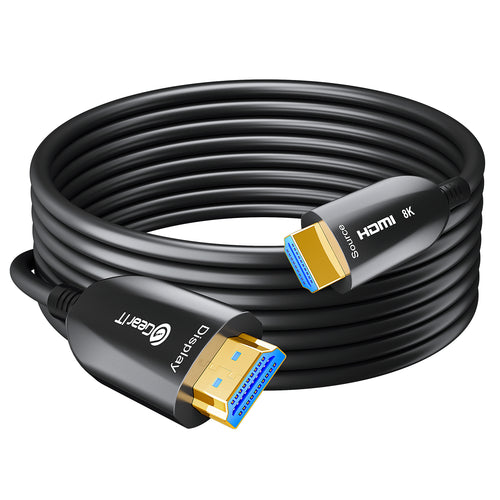
In the world of home theater systems, audio quality can make or break the viewing experience. To achieve top-notch sound, understanding the role of Audio Return Channel (ARC) and its enhanced counterpart, eARC, is essential. This article will guide you through the basics, technical differences, evolution, benefits, setup, and future trends of ARC and eARC, helping you make informed decisions for your home theater audio setup.

What is ARC?
ARC, or Audio Return Channel, is a feature introduced with HDMI 1.4 in 2009. It allows audio signals to travel both to and from the television, simplifying the connection between your TV and external audio systems like soundbars and AV receivers. With ARC, a single HDMI cable can handle both video and audio, reducing the need for additional cables and connections.
What is eARC?
eARC, or Enhanced Audio Return Channel, is the next step in the evolution of ARC, introduced with HDMI 2.1. eARC significantly improves upon ARC by offering higher bandwidth and supporting advanced audio formats. This enhancement ensures a richer and more immersive audio experience, making it ideal for modern home theater systems.

Bandwidth Capabilities
One of the most significant differences between ARC and eARC is the bandwidth. ARC has a limited bandwidth of up to 1 Mbps, which is sufficient for compressed audio formats but falls short for high-resolution audio. In contrast, eARC offers a substantial bandwidth increase up to 37 Mbps, allowing it to handle uncompressed audio formats.
Audio Quality
The increased bandwidth of eARC translates to better audio quality. While ARC supports formats like Dolby Digital and DTS, it cannot handle advanced formats like Dolby Atmos or DTS in their full, uncompressed form. eARC, however, can transmit uncompressed 5.1 and 7.1 surround sound, as well as high-bitrate audio like Dolby TrueHD and DTS-HD Master Audio. This capability ensures a more detailed and immersive audio experience.
Support for Advanced Audio Formats
ARC supports compressed audio formats, which can limit the audio experience in high-end systems. eARC, on the other hand, supports the latest audio technologies, including Dolby Atmos and DTS. These formats provide 3D audio, creating a more immersive soundscape that enhances the overall viewing experience.

From HDMI 1.4 to HDMI 2.1
The journey from ARC to eARC reflects the broader evolution of HDMI standards. ARC was introduced with HDMI 1.4, which brought the convenience of a single cable for audio and video but was limited in audio bandwidth. HDMI 2.1, which includes eARC, addresses these limitations by significantly increasing bandwidth and supporting a wider range of audio formats. This evolution is crucial for keeping up with advancements in audio technology and delivering high-quality sound in home theater systems.

Uncompressed 7.1 Audio
One of the standout benefits of eARC is its ability to handle uncompressed 7.1 audio. This feature ensures that the audio quality remains intact, providing a true-to-source sound experience that is critical for audiophiles and home theater enthusiasts.
Faster Speeds
eARC offers faster data transfer speeds, which means lower latency and a more synchronized audio-visual experience. This improvement is particularly beneficial for gaming and high-action movies where audio delay can disrupt the experience.
Support for Latest Audio Technologies
eARC supports the latest audio technologies, including Dolby Atmos and DTS, allowing users to enjoy cutting-edge audio formats. These technologies create a 3D sound environment, making the audio experience more immersive and realistic.

Compatibility with Existing Equipment
Before setting up ARC or eARC, it's essential to check the compatibility of your existing equipment. Ensure that both your TV and audio device (soundbar or AV receiver) support ARC or eARC. Most modern TVs and audio systems are equipped with these features, but verifying this can prevent setup issues.
Connecting Devices
Setting up ARC or eARC typically involves connecting your TV and audio device using an HDMI cable. For ARC, connect the HDMI cable to the ARC-enabled HDMI port on both devices. For eARC, use an HDMI 2.1 cable to connect the eARC-enabled ports. Ensure that both devices are configured to use ARC or eARC in their settings menus.

Emerging Technologies
The future of home theater audio is exciting, with new technologies like Dolby Atmos FlexConnect on the horizon. These advancements aim to integrate seamlessly with existing ARC and eARC setups, providing even more flexibility and immersion in audio experiences. Dolby Atmos FlexConnect, for example, promises to enhance audio placement and quality, making it easier to create a surround sound experience without the need for numerous speakers.

Wireless Systems
A significant trend in home theater design is the move towards wireless audio systems. Wireless speakers and soundbars are becoming more popular, offering cleaner setups and easier installation. This trend is likely to continue, with eARC-compatible wireless systems providing high-quality audio without the clutter of cables.
Architectural Speakers
Another trend is the integration of architectural speakers that blend seamlessly into the room's design. These speakers can be built into walls or ceilings, providing a minimalist aesthetic while delivering high-quality audio. The combination of eARC and architectural speakers can create a sophisticated and immersive home theater experience.

What to Look For
When purchasing home theater equipment with ARC or eARC capabilities, consumers should consider the following:
1. Compatibility
Ensure your TV and audio devices support ARC or eARC.
2. HDMI Cables
Use HDMI 2.1 cables for eARC to ensure optimal performance.
3. Audio Formats
Look for devices that support advanced audio formats like Dolby Atmos and DTS
4. Future-Proofing
Consider equipment that supports the latest standards and technologies to ensure longevity and compatibility with future upgrades.

Understanding the differences between ARC and eARC, along with their technical specifications and benefits, is crucial for optimizing your home theater audio experience. As HDMI standards continue to evolve, embracing eARC can ensure you stay ahead of the curve, enjoying the latest in audio technology. Whether you're setting up a new system or upgrading an existing one, being informed about ARC and eARC will help you make the best choices for a high-quality, immersive audio experience in your home theater.
If you're interested in any of the products we've mentioned, you'll find our curated recommendations listed below. When you order through our website, you not only support a small business but also enjoy exclusive benefits such as personalized customer service, special discounts, and fast shipping. Plus, our team is always here to assist you with any questions or concerns.




















































